Sedona is a medium town roughly in the middle of the state of Arizona. Set within the vast Coconino National Forest and at the end of the Oak Creek Valley, this area of Arizona is spectacularly beautiful, offering a mix of red rock desert and lush forest. Sedona is understandably a popular destination, and there’s so much to do here that it can seem daunting to plan a visit. Our guide focusses on some of the best hikes in the area as well as exploring some of the other options in terms of things to do, places to stay and where to eat.
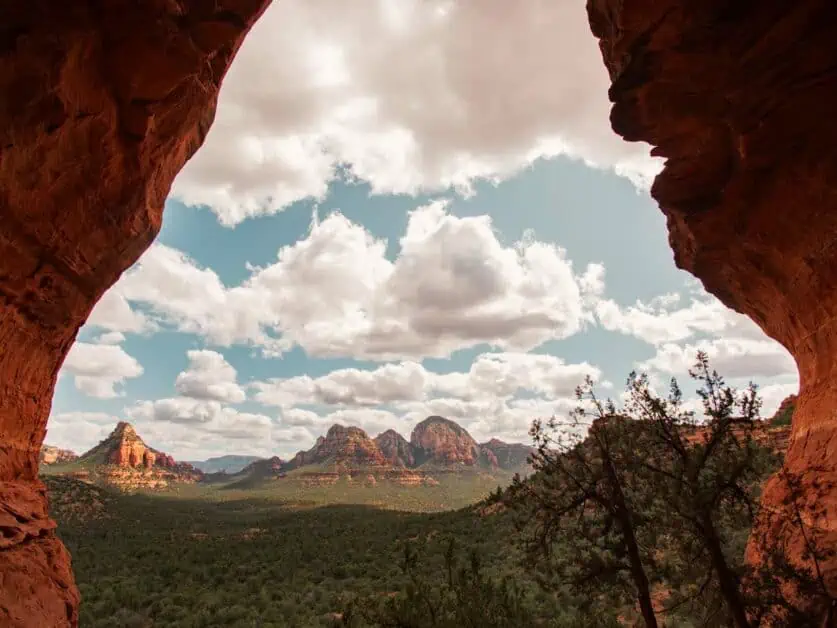
Editor’s Note: This article is in partnership with Visit Arizona all opinions are our own. Be sure to read our other articles in this series: 14 Amazing Hikes in Sedona, Arizona and Things to do in Page, Arizona
Table of Contents
Why Should You Visit Sedona, Arizona?
Quite simply put, Sedona is stunningly beautiful. Sedona’s own tourism board call it ‘The Most Beautiful Place on Earth.’ They are surely biased, but you can see where they are coming from as Sedona is surrounded by some of the most jaw-dropping scenery you’re likely to find in the United States. In the countryside around Sedona, you’ll find a desert landscape of towering red-rock buttes and mesas that almost look like they could belong on the surface of Mars alongside dense pine forest, open prairie, deep canyons and winding streams that are iconic of the American West.
The area is crisscrossed with over 640km/400miles of generally very well-marked trails, with options suited for hiking, mountain biking, horse riding and off-road driving, to name a few activities, so access to this natural splendor is both relatively easy and available to people with all levels of fitness and experience – many of the most spectacular hiking routes are easily accessible from the town and are certainly suitable for beginner or novice hikers.
Moreover, the town of Sedona itself offers fantastic hotels, restaurants, bars, cafes and shopping opportunities, making it a perfect base to explore the surrounding countryside. Sedona is, understandably, a very popular destination, and at times it can feel very busy in places. However, once you hit the trails, you’ll quickly leave the crowds behind and it’s easy to find some true peace and solitude in nature here.
The Best Time to Visit
Sedona may be visited year-round. As you would expect, the temperature does fluctuate through the year – with daily highs of over 30C/90F in the summer months (June to September) and lows around freezing from December to February. However, the extremes aren’t as great as you might find in other parts of the country – even in other parts of Arizona – and Sedona is not subject to seasonal closures due to heavy snow fall (though it can and does get some snow – which, on the red rock landscape – can look genuinely magical).
As with many of the dryer parts of America, there’s a real risk of wildfire in some of the forest areas surrounding Sedona and this can lead to areas of the Coconino National Forest being closed to the public to help mitigate this risk. The most popular times to visit Sedona is spring – March to May – followed by September to mid-December. Late in October the foliage starts to change color and Sedona is an incredible destination to see fall or autumn colors.
These two peak seasons offer the best temperate weather for hiking and outdoor exploration; however, this is also when Sedona will be at its busiest and accommodation prices will also be highest. The temperatures may not be quite as ideal for exploring off season, but they are also not super-extreme, and this is also when you will find the area quieter and with slightly lower accommodation costs.
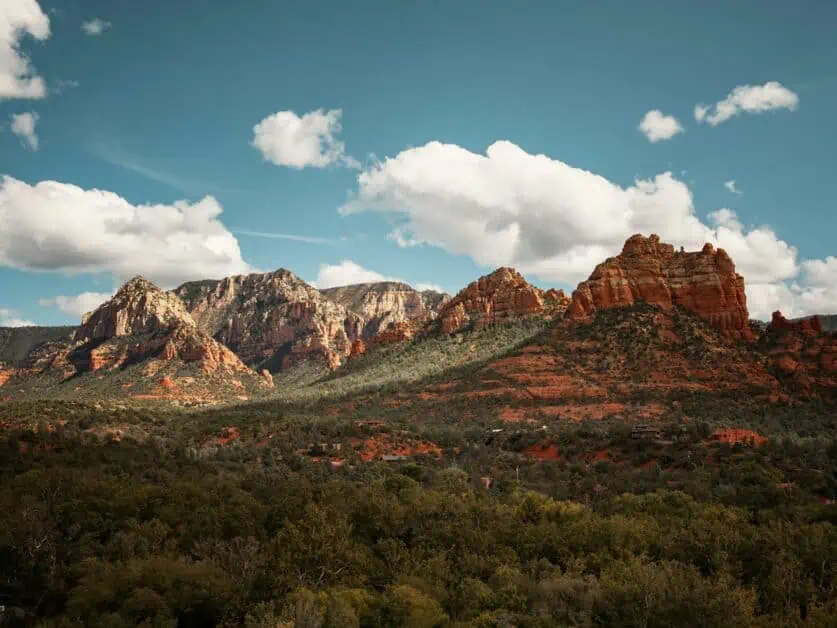
Things to do in Sedona, AZ
Sedona itself is a fairly compact town and, refreshingly, much of it – especially the Historic Uptown area to the east – can be explored on foot. Uptown is where you’ll find the main shopping area, with numerous shops and galleries both on the street and in smaller arcades and malls. Heading west, away from Uptown, things start to space out a bit more and you’ll find larger restaurants, supermarkets and stores. The town is undeniably a popular tourist destination and many of the shops you’ll find here cater to tourists, selling native art and new-age spiritual goods. However, there are also plenty of outdoors stores with all the equipment hikers are likely to need in the town too.
Tlaquepaque Arts & Shopping Village
Situated on the edge of Sedona’s uptown area, the Tlaquepaque Arts & Shopping Village – its name translates as the ‘best of everything’ in the Nahuatl language used by the Aztecs – is often listed as a must-visit attraction in Sedona. This complex of interconnected buildings, courtyards, and walkways, with some structures even constructed around trees, make the place seem like it has some very deep history (our first thought was that it was originally some sort of monastery form the 1539 to 1821 period of Spanish colonial rule in what’s today called Arizona).
However, the reality is quite different, and the site actually dates from the 1970s. It was the shared vision of developers Abe Miller and architect Bob McIntyre, who wished to recreate the feel and experience of a Mexican village. The site’s interesting history aside, it is home to a number of artist’s studios, galleries, workshops and cafés. If you are interested in locally produced arts and crafts, ranging from paintings to sculpture to ceramics alongside crystals, fossils, vintage vinyl and second-hand books, locally produced wine, handmade toys and much more besides, this is the place to visit and the twisting, eccentric layout of the village makes it your time here even more memorable.
The Tlaqepaque Arts & Shopping Village is situated near the center of Sedona at the start of the Red Rock Scenic Byway. If you are exploring Uptown Sedona, you could easily walk here or, alternatively, there’s plenty of free parking on site. The main retail stores are typically open Monday to Thursday from 10am to 5pm, and Friday to Sunday 10am until 6pm whilst the restaurants on site generally stay open later.
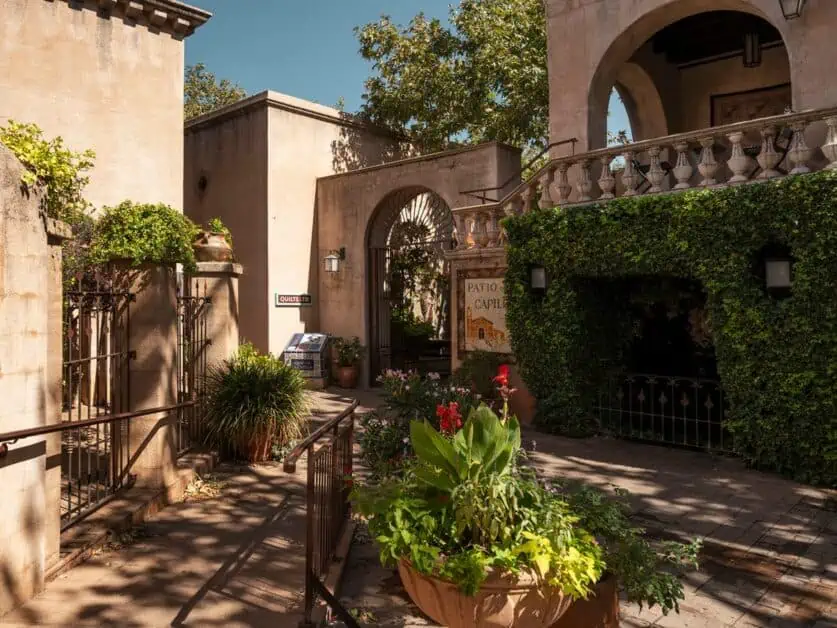
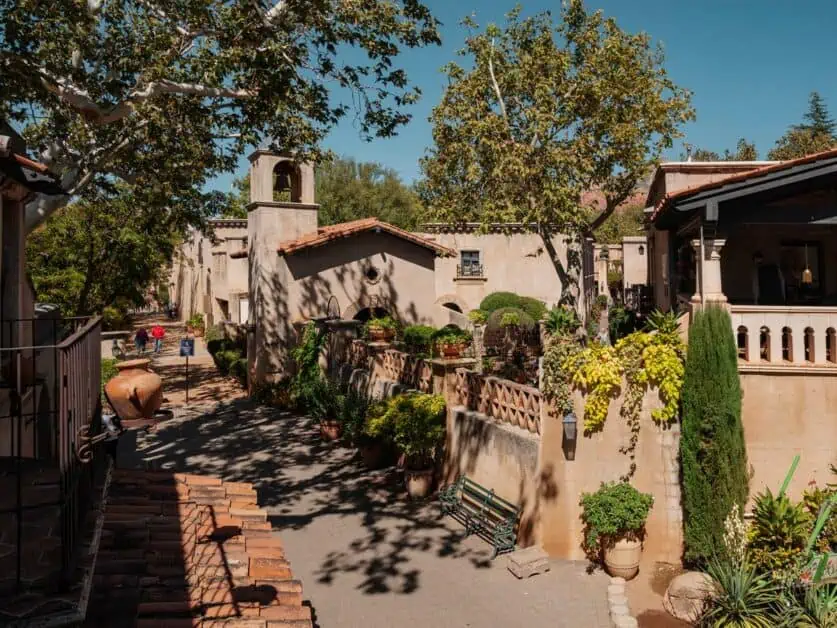
Sedona Heritage Museum
The Sedona Heritage Museum – located on 735 Jordan RD in Uptown Sedona – focusses on the relatively short modern history of Sedona. The area was first settled by Americans of European origin in the late 19th Century (though, of course, Native American people have called the area home for far, far longer than this). The town was named after Sedona Schnebly, the wife of TC Schnebly, whom, together with his brother Ellsworth, had set up the settlements first hotel, general store and post office.
The museum’s exhibits focus on the agricultural history of the town and later its association with the movie industry – from the 1920s on, numerous Westerns were filmed in and around Sedona – a legacy that lives on in the street names in the west of the town, many of which are the names of movies.
The museum is open 11am to 3pm every day apart from major holidays and admission costs $7 for anyone aged over 13 (under 13s are free). Alongside exhibits and an extensive local archive, the museum also offers a History Alive experience costing $15 for anyone over 13, roughly once per month where reenactors recrate the lives of the settlers who founded modern Sedona.
Palatki and Honanki Heritage Sites
Palatki and Honanki are two very important historical sites near Sedona. These sites are the remains of cliff dwellings – essentially stone structures built into the surrounding red rock cliffs – and are understood to have been home to members of the Native American Sinagua Tribe (who some members of the Hopi tribe believe to be their ancestors) who inhabited the area from approximately 1150 to 1350. Beyond the structures themselves, the rock walls at both sites have numerous petroglyphs and pictographs which predate the structures.
Some of the petroglyphs at Palatki are estimated to be 5000 – 6000 years old! Both sites offer a spectacular and fascinating glimpse into the rich native history of the land around Sedona. Both sites are relatively close to each other and it’s possible to see both in one visit.
Palatki
Palatki is located at 10290 North Forest Service RD #795, roughly 29km/18mi from Sedona. Getting to the site requires driving some distance on unpaved roads – though the route is suitable for regular road cars. The site is open daily from 9:30am to 3pm and the only way to explore it is as part of a guided tour – the last of which starts at 2pm. Booking in advance is essential and this may be done at the recreation.gov website. Tickets are free, but there is a $1 booking fee per ticket. A Red Rock Pass is also required to visit this stie.
Honanki
Honanki is located relatively close to Palatki at 1450 N Loy Butte Rd, roughly 33km/20.5mi from Sedona. Reaching the site also involves driving on an unpaved road and in places, this can get rough and a 4×4 vehicle is recommended to reach Honanki. There is a small visitor center at Honanki and it’s possible to join a guided tour here, however visitors can also explore the site on their own. A Red Rock Pass is also required to visit this site.
Red Rock Scenic Byway
The Red Rock Scenic Byway – more correctly, though less romantically, called State Route 179 – runs south from Sedona, where it joins with route 89a in the town center, to Interstate 17. The total distance is just under 25m/15.5mi, but this short stretch of road packs in some truly incredible scenery and panoramic views. Driving south from uptown Sedona, you’ll pass the Tlaquepaque Arts & Shopping Village very soon after turning onto the Scenic Byway. From here, it’s a short distance unto you reach the town limits of Sedona, and shortly after this, the vistas open up.
The Red Rock Scenic Byway is a fantastic way to experience some of the most expansive and spectacular views in the area and gives amazing viewpoints on some of the most iconic red rock formations surrounding Sedona including Courthouse Butte, Bell Rock, Gibraltar Rock and Cathedral Rock. There are numerous parking areas along the route and these not only serve as a place to get a longer view of the scenery, but are also contain trailheads to the numerous trails that crisscross the landscape here. There are some great hiking trails in this part of Sedona, including the Courthouse Butte and Bell Rock Loop (the route for which is provided later in this article).
A Red Rock Pass is required to park in the various carparks along the Red Rock Scenic Byway and you should be aware that these car parks do fill to capacity during peak times – if you plan to hike in the area, it’s good to get there either early or later in the day. This area is also where you’ll find the Chapel of the Holy Cross – one of the most well-recognized buildings in Arizona.
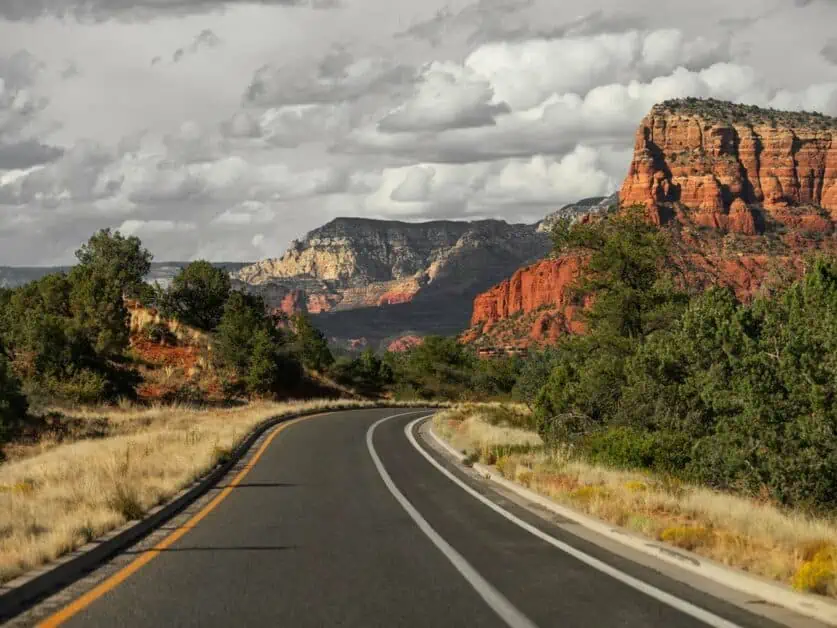
Slide Rock State Park
Slide Rock State Park is a 10-minute drive (approximately 11km/7mi) North of Sedona on the 89a. The ‘Slide Rock’ after which the park is named is, remarkably, a natural waterslide that’s been eroded in the sandstone by Oak Creek. This roughly 24m/80ft long chute is coated with slippery, but otherwise harmless algae and has a seven percent incline, allowing swimmers to slide along its length – just like you would at a water park! Aside from the Slide Rock, there’s also a 0.8km/05mi stretch of Oak Creek in the park that’s open for swimming.
Whilst this is generally considered a family-friendly site to visit, it’s well worth bearing in mind that there are no lifeguards on duty and at some times, the water in Oak Creek and be extremely cold – close to freezing, in fact – so be sure to exercise the appropriate caution if you want to get into the water here. Aside from water-based activities, there are several short hiking trails in the park and it’s also a great place for wildlife watching with the small Coues Whitetail Deer, Javelina (a type of wild pig) and even, occasionally, Black Bears visiting the park.
The park is open seven days a week (it’s closed on Christmas day) from 8am to 6pm between 03 February and 01 December and from 9am to 5pm from 02 December to 02 February. There are reduced opening hours – 9am to 2pm – on Thanksgiving and Christmas Eve. Access to the swimming area and slide rock closes an hour before the park shuts. Entry fees are, frankly, complex, and vary based on the time of year and number of people in each vehicle, but for up to four people in a regular car, they are typically $20 per vehicle during peak season – though this does go up to $30 per vehicle Friday to Saturday from the Friday before Memorial Day to Labor Day. During low season – November to February – the cost per vehicle is $10 at all times.
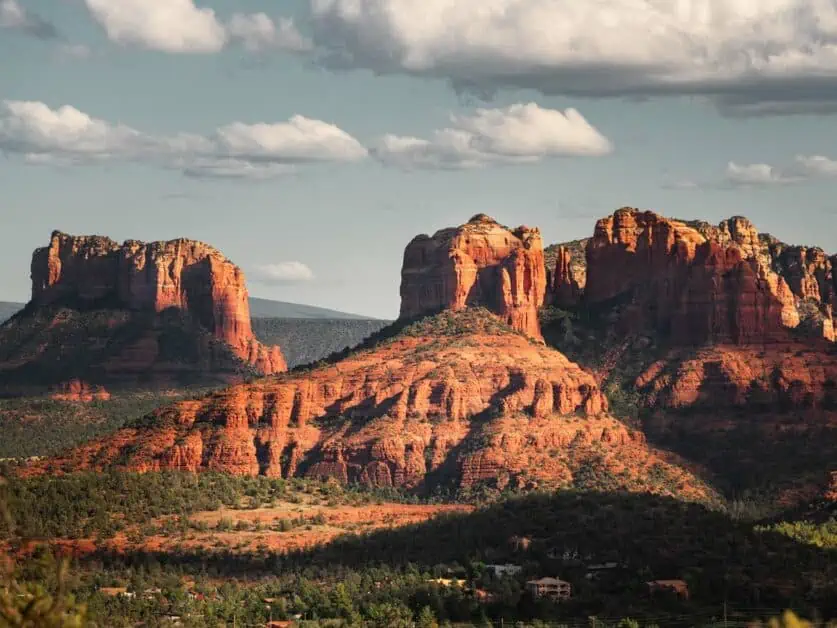
Sedona Trolley Tour
The Sedona Trolley Tour is a popular, guided bus tour on open-sided buses that operates around the town of Sedona. Two tours are offered: One heads south on the Red Rock Scenic Byway and includes a short visit to the Chapel of the Holy Cross – this tour departs at 11am and 2pm seven days a week. The second our heads west from the town taking in views of some of the area’s iconic red rock formations and culminating at the beautiful Fay Canyon – this leaves at 10am, 13:30pm, 3:30pm and 5pm seven days a week. The tours are a great way for visitors to get an overview of the town, it’s history and surrounding landscape. Each tour lasts just under an hour and is fully narrated by an on-board guide. Tours cost $23.99 for adults and $15.99 for children under 12. It’s also possible to combine both tours for $37.99 for adults and $21.99 for under 12s.
Sedona Vortex Sites
Spend even the briefest amount of time in Sedona and you’ll see that the area clearly has a major significance to Spiritualists, and Native American, Eastern and New Age spiritual philosophies are all widely practiced in the area. There are numerous businesses in the town offering crystals and spiritual talismans, psychic readings, aura photography and alternative healing therapies. You’ll also rapidly encounter references to ‘Vortex Sites’. The idea of the Vortex Sites emerged in the 1980s and there are various explanations for them ranging from them forming at the intersection of energy or Ley Lines to them being energetic manifestations of subterranean artefacts or structures – some of which may be of extraterrestrial or even inter-dimensional origin.
Suffice it to say that the existence of these Vortex Sites and their various explanations sits well outside of mainstream scientific acceptance. Many of the Vortex Sites – or Vortices – correspond to sites that have been sacred to Native American Tribes for millennia. Regardless of whether you believe in their energetic qualities or not – and a lot of people take them very seriously indeed – many of the vortexes exist in stunningly beautiful locations such as Bell Rock, Cathedral Rock and the Birthing Cave, which you will surely visit if exploring Sedona. It is not uncommon to encounter people carrying out rituals or ceremonies or simply meditating at these locations.
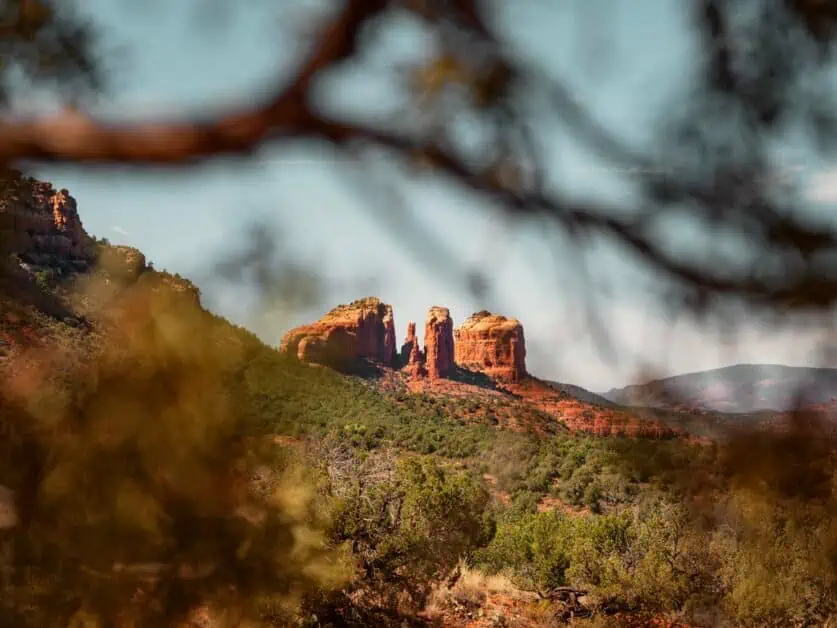
Chapel of the Holy Cross
The Chapel of the Holy Cross is arguably the most iconic building in Sedona and probably one of the best-known in the state of Arizona too. The chapel is considered a masterpiece of mid-twentieth century American architecture. More specifically, the chapel is a Contextualist building, meaning its design was inspired by the characteristics of the surrounding landscape. Built between 1955 and 56, the building was designed by architects Richard Hein and August K Strotz, working under the patronage of local artist Marguerite Staude.
Driving along the Red Rock Scenic Byway, it’s possible to get some incredible views of the chapel from a distance – it can be tricky to spot at first, as, despite its angular form, it does compliment the surrounding landscape well. The chapel is located at 780 Chaple RD, AZ 86336, is open seven days a week from 9am to 5pm and there is some limited parking (45 spaces) near the chapel. From the outside of the chapel, there is an incredible panoramic view over the surrounding landscape. This chapel is a consecrated Roman Catholic Church and regular masses and services are held there.
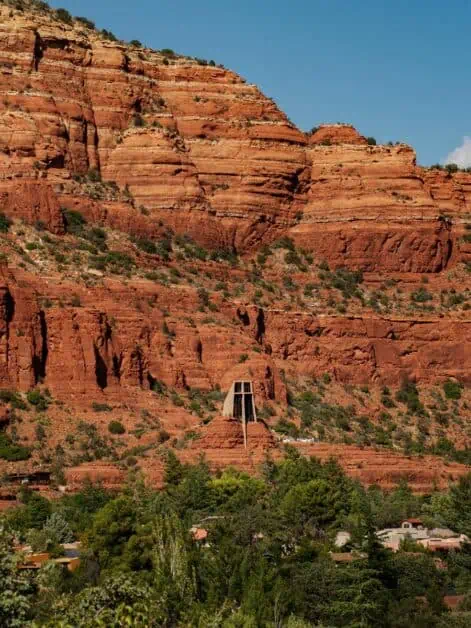
Amitabha Stupa and Peace Park
Sedona has long captivated those with spiritual and metaphysical beliefs. The Vortex Sites around the area are a draw for those with many different belief systems. It’s perhaps not surprising to learn about the Amitabha Stupa and Peace Park. It’s important to note that the Stupa is not considered a Vortex but is a type of Buddhist shrine. These structures – which have a history dating back over 2500 years – are considered ‘Wish fulfilling jewels’. Essentially, Buddhists consider that the significance of meditation, rituals and prayers conducted around the Stupa will be amplified. Stupas are a relatively common sight in the east – if you have ever trekked in the Himalayas, you’ll likely recognize them – but there are very few in the west.
The site around the Peace Park houses several other ritual structures that can be used to help focus spiritual or meditative practice: These include a second, smaller Stupa (the Tara Stupa), Buddhist Prayer Flags and Prayer Wheels and a Native American Medicine Wheel. The medicine wheel may seem like an odd addition to a site that’s clearly focused on Buddhist practices, but its inclusion is based on Buddhist and corresponding Hopi traditions that have been interpreted as predicting a link between Tibetan and Native American people.
The Peace Park will certainly appeal to those who are keen to explore the spiritual aspects of Sedona, but it is also a tranquil space, surrounded by great natural beauty, with several trails to explore. The park is open from dawn to dusk seven days a week, with parking available from 8:30am to 5pm. It is free to visit and is in western Sedona at 2650 Pueblo Drive, AZ 86336.
Stargazing
Sedona is a great place for looking at the stars. The desert skies are often clear, and the light pollution caused by the town of Sedona can quickly be left behind if you head just a little bit out of town. As with all desert environments, the temperature can drop considerably at night – especially so on cloud-free evenings – and a very warm day can absolutely be followed by a very cold night! So, be prepared and plan accordingly and be sure to bring appropriate clothing. The reward for this can be spectacular and on clear nights, the light pollution-free skies can yield beautiful, deep star fields and rich views of the Milky Way. Sedona is not just a great spot for astronomy with telescopes, but also a great place to practice astro photography incorporating the landscape.
Natural Swimming Holes
Open water swimming might seem like an unusual activity in what’s essentially a desert, but Oak Creek, which winds its way through Sedona provides several spots that are perfect for just this. The swimming here is very different to what you might find in more temperate areas: there are no huge expanses of water suitable for long swims. Instead, the river provides several smaller pools or swimming holes – whilst some are small or shallow, there are points where it’s still possible to have a substantial swim in deep water.
The water in Oak Creek can be surprisingly cold – even on very warm days, so, as is always advised with open water swimming, it’s smart to check the water temperature and acclimatize by entering the water gradually rather than just jumping straight in. Our guide to cold water swimming has some great tips if you are interested in swimming around Sedona.
Grasshopper Point
Grasshopper Point Swimming and Picnic Area is a six-minute drive (4km/2.5mi) north along the 89a from uptown Sedona. The site is open from 8am to 6pm between 01 April and 31 October and from 9am to 6pm from 01 November to 31 March. The exit gate is locked at dusk each day. There is a $12 per vehicle, per day fee to use the site. This popular site is located at a bend in Oak Creek and presents a deep pool, great for swimming. There are steep, but easily climbed, near-vertical rocks on one side of the river and it’s popular for swimmers to jump or dive into the river from these.
This, however, is not recommended and even actively discouraged by the Forest Service who administer the site as the water has varying depth and there can be unseen hazards below the surface that can seriously injure those jumping or diving in. Remember, if you intend to enter the water, that there are no lifeguards on duty.
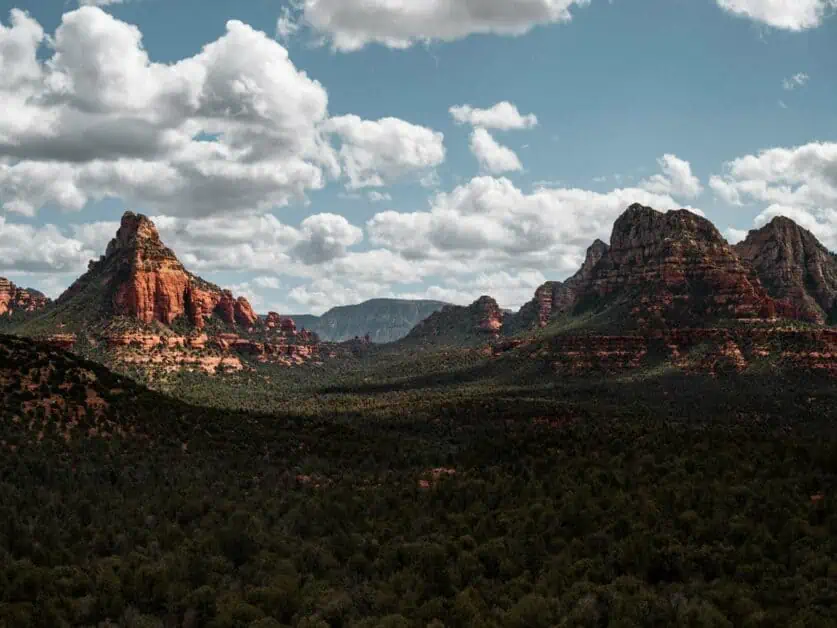
Crescent Moon Ranch
Crescent Moon Ranch, also referred to as Crescent Moon Picnic Site, is located roughly a fifteen-minute drive (11.5km/7.2mi) South-West of Uptown Sedona. To reach it, you first head West through Sedona on the 89a, before turning left onto the Red Rock Loop Road – this smaller road has some fantastic panoramic viewpoints over the surrounding landscape and drops down into the valley before turning onto Chavez Ranch Road and then Red Rock Crossing Road before finally reaching Crescent Moon Ranch itself.
The ranch is open from 7am to 7pm from 01 April to 30 September; 8am to 6pm from 01 October to 30 November and 9am to 5pm from 01 December to 31 March. There is a $12 per day access fee per vehicle to use the site. The real attraction of Crescent Moon Ranch are the incredible views of Cathedral Rock you get from the site. This makes the site very popular, and it can get very busy.
Once again, the river here is Oak Creek and there are numerous points near the main picnic area where the river is accessible and where swimming is possible – at points, breaks in the trees reveal spectacular views of Cathedral Rock only visible from the middle of the river. Some of the pools here are large and it’s possible to swim a decent distance in deep water – similar to a medium sized swimming pool. However, it’s worth bearing in mind that the river current can quickly pick up and become very strong outside of the swimming spots. As with Grasshopper point (above) there are no lifeguards on duty here.
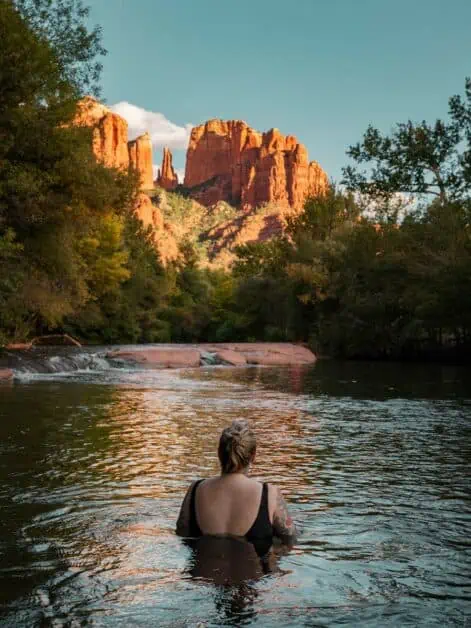
4×4 Offroad Tours
There are numerous offroad and 4×4 trails around Sedona in the Coconino National Forest, and exploring these is a great way to get further off the beaten path, away from the crowds and deeper into nature. These routes often lead to spectacular viewpoint that would otherwise be extremely difficult to reach. Companies such as Pink Adventure Tours – their pink Jeep Wranglers are a ubiquitous sight around Sedona – offer a range of tours out into the backcountry around Sedona. For those who are feeling a bit more adventurous, it’s absolutely possible to rent a Jeep or an ATV in Sedona and explore the trails yourself.
The Forest Service publishes a map giving a comprehensive overview of off-road trails and their difficulty in the area. Note that the Casner Mountain and Soldier Pass trails require permits to drive – more info on permits is available from the Forest Service. Some of the offroad trails are considered advanced routes and should not be attempted unless you have previous offroad driving experience. If you don’t, but would still like to experience these, then a guided tour is a good option.
Hiking the Sedona Trails: Tips for Beginners and Pros
- Stick to the marked trails: There are some incredibly sensitive sites of interest in and around Sedona, with some having cryptobiotic crust present – if affected, this can take an extremely long time to regenerate. Whilst red rock country can feel like it’s a paradise waiting to be explored off grid, the marked trails are there for a reason. There’s also the safety aspect too – many areas are slick rock, and this can create serious slipping hazards, so always stick to the trails when visiting Sedona. For more information on hiking in Sedona check out our full article here.
- Get there early or late: Sedona can get really busy for hiking, and as such, the parking lots can fill up quickly. So always have a backup plan when it comes to your hike and consider some of the quieter trails as well (we’ve outlined some of these below in our hiking routes). You’re more likely to get a parking space if you arrive early or later in the day. Alternatively, you can catch the free shuttle bus from Sedona itself, which runs on certain days, for more information on this visit the Sedona Shuttle website.
- Go prepared: Whether you’re used to hiking in the desert or not, you should always go prepared for hiking in Sedona as it can get pretty hot out there on the trail! There is pretty much no shade on most of the trails so bring more water than you think you need. This will of course depend on the length of trail you’ll be doing/your activities for the day. We’d always advise to keep more in your car too. Be sure to bring a hat, sunscreen and layers to cover your skin if needed. Also, if it is too hot, and you’re finding it tough, always turn back. It’s worth educating yourself on the signs of heat stroke and heat exhaustion. Stick to earlier and later activity and consider going outside of the summer months for the best experience.
- Download your map in advance: Sedona’s hiking trails have very little signal, so make sure you download your map and check it before you head out. Whilst the trails are well marked, you cannot rely on this. It is also a good idea to bring a paper map and hiking compass and know how to use it.
Hiking essentials: gear recommendations, maps, and safety precautions
There are a number of things we consider as essential for hiking in Sedona to allow you to have the best experience of the trail:
- Sunscreen: This is a must for anyone, most trails are very exposed, and we’d recommend at least factor 30 or higher.
- A hat: To keep your head covered from sun exposure.
- Plenty of water: It can get extremely hot out on the trails in Sedona and the air is dry, so bring plenty of water – depending on your set up, you may find that a water bladder in your backpack may be the best option for ease. We like this one from Osprey.
- Tech fabric: You should make sure that the clothing you wear out on the trail is tech fabric and has moisture wicking qualities. Fabrics like cotton are bad for hiking trails in Sedona as it soaks up sweat and can lead to you being drenched. Fabrics that wick the moisture away from your skin and dry quickly are ideal.
- Quality footwear: Many of the surfaces around Sedona are slick rock and in turn can be quite slippery. You’ll want hiking shoes with a good tread and good ventilation. Generally, waterproof hiking shoes are going to work well for you in a whole range of circumstances, and because they’re designed for slippery surfaces, tend to have a heavier tread pattern.
- Maps: We generally like to use Outdooractive mapping software on our mobile devices, which you’ll find linked up to our hiking guides below. This allows you to serve a downloaded version to your phone. We’ll usually bring a battery charger with us just in case, but it’s always wise to bring a paper map and hiking compass and know how to use it too, just in case!
Spotlight on popular trails: difficulty, distance, and distinct attractions
One of the incredible things about Sedona is that when you look at the area on a map, you’ll see there are so many hiking trails dotted around. It would be impossible to hike everything around the area, but that’s one of the things that’s great about it and keeps adventure lovers coming back time and time again. The hiking trails we’ve outlined with maps below only scratch the surface of what is available, but here are some of the most popular hiking trails in Sedona:
- Cathedral Rock Hike: A challenging hike which can be completed all year. Has 200m/656ft. ascent and descent and is 2.8km/1.7miles. One of the most iconic hikes in Sedona.
- Birthing Cave Hike: A moderate hike with a short scramble toward the cave. This can be completed all year. This hike comes in at 3km/1.86miles with 71m/233ft. ascent and descent. Large cave with views out over the red rock of the area.
- Courthouse Butte and Bell Rock: This trail is varied with red rock formations, far reaching views and well-known vortex sites. This trail can be completed all year round and is very popular. It is 6.1km/3.7 miles as a loop with 117m/383ft. ascent and descent.
- Fay Canyon: A well-known trail in the heart of red rock Sedona and at the end of the trail, you have fantastic views into the valley (the arch is well worth the effort). You can hike this trail all year round and it’s classed as moderate. It comes in at 3.9km/2.42miles and 91m/298ft. ascent and descent.
- Seven Sacred Pools via Soldier Pass: Highly recommended to climb up to the caves on this trail for some of the most spectacular red rock views. This trail is classed as moderate, and the shuttle service is available as the parking lot is small. The length of this hike is 8km/4.97miles with 258m/846ft. ascent and descent.
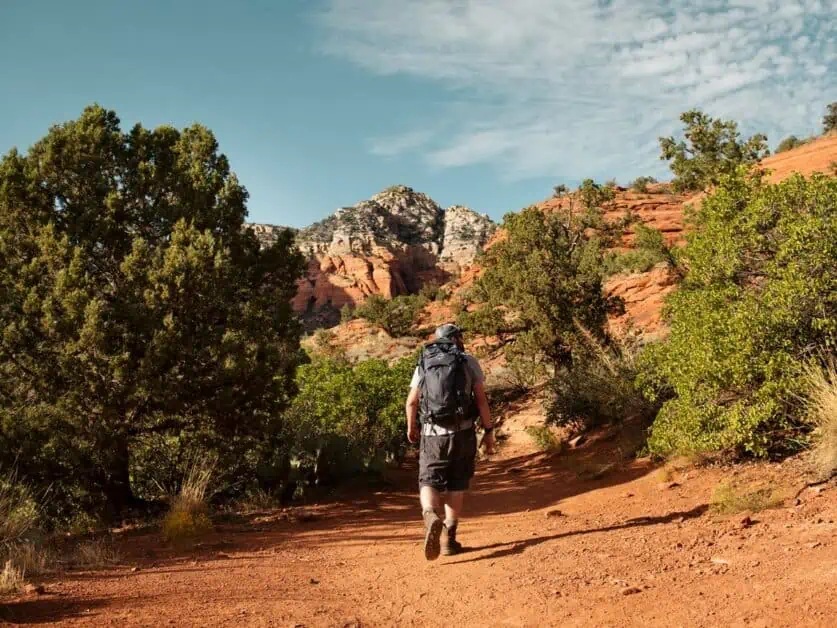
Red Rock Pass and Alternatives
Throughout this article, you’ll find regular references to a Red Rock Pass. This is a permit that is required to be purchased and displayed in your vehicle if you wish to park at numerous trailheads in the area. The pass is inexpensive, and a single pass may be used at multiple sites whilst it’s valid – you don’t need a new pass for every place you park in a day. At the time of writing, a daily pass costs $5 and a weekly pass costs $15. A $20 annual pass is also available. The revenue from the sale of Red Rock Passes is reinvested into maintaining trails and trailhead car parks and facilities around Sedona and you risk a fine if you don’t have a pass. The main car parks – for instance, those along the Red Rock Scenic Byway – have vending machines where Red Rock Passes can be purchased.
It’s also possible to purchase the pass online at the Recreation.gov website – in this, case, no paper pass is required to be displayed as the pass is associated with your vehicle’s number plate. Various Interagency Passes may also be displayed instead of Red Rock Passes. The America the Beautiful Pass, for instance, costs $80 and allows 12 months of unlimited access to National Parks and numerous recreation areas (though not State Parks) and can also be displayed instead of a Red Rock Pass. This pass makes a lot of sense if your visit to Sedona is part of a larger trip that includes some of the relatively nearby National Parks and Recreation Areas such as the Grand Canyon and Glen Canyon or Zion and Bryce National Parks in Southern Utah. You can purchase and America the Beautiful Pass online here.
Wildlife watching and photography tips
Sedona is an incredible place to photograph; with its endless red rock formations and interesting shapes and textures, you’ll be visually amazed by what you get to see. It’s worth using longer and shorter lenses whilst out hiking and exploring around Sedona. Shorter lenses can give you those great overview shots – if you’re going to be hiking the Birthing Cave or Fay Canyon for example, an extra wide angle is handy to capture and frame the caves. You’ll also make good use of longer lenses for capturing more distant scenes and picking out rock detail: you can get some really interesting shots by framing trees and scrub. Heading out toward the later part of the day is sure to give you some amazing shots too – as the light lowers, the rocks seem to illuminate, often becoming fiery orange.
In terms of wildlife, you can expect to see the likes of bobcats, coyotes, mule deer and javelina as well as a variety of birds. Though if you’re interested in birds, you’ll want to look at bringing some binoculars. If you’re aiming to photograph animal life in Sedona, you’ll need to devote some time to this, and you can find out more about the animals that call this area home as well as the best times and places to spot them through the AZ State Parks website.
Ethical and Sustainable Exploring
It’s really important, now more than ever, to plan your travels in a sustainable and ethical way. As tourists, we have an impact on the places we visit. Sedona is a very popular place, and with some adjustments, you can make your experience of this fantastic area that bit more sustainable. The landscape begs to be explored, and one of the biggest things that you can do to explore consciously is to stick to trails. It is incredibly important to remember the cultural sensitivity of the area too – as much of the land in and around Sedona is incredibly important to Native American tribes. As a general rule, exploring the world around us is a privilege and respecting the landscape for other visitors for years to come is the best thing you can do to minimize your impact.
Leave No Trace
Of course, the desert can seem like a hostile environment however it is delicate and needs to be looked after. When visiting an area like Sedona, we have a responsibility to have as little impact as we can. If you aren’t already aware, Leave No Trace is a set of principles that we can all follow to help make our time outdoors as sustainable as possible. By practicing Leave No Trace we can preserve natural environments for years to come and leave them better than we found them. You can check out the 7 main principles of Leave No Trace here.
How to be a Sustainable Visitor
Given that Sedona is a very popular area, it is important to put sustainability at the forefront of your mind when visiting. For example, always make sure you have a backup plan for a hike you may want to do. Many of the parking lots can become busy very quickly so having an alternative means that popular sites aren’t congested. Always park in marked areas – as otherwise you may prevent access that is needed to certain areas. You can always make use of the free shuttle service from Sedona too (details here). Consider visiting at less busy times as well – typically earlier or later in the day are good as many people will have left by this point.
This also applies to when you visit – as peak times will be busier and put more of a strain on local resources. You could also consider staying outside of Sedona too – in areas such as Flagstaff that are under an hour away by car. It’s also important where possible to buy from local businesses too. Sedona has a wealth of great restaurants, food places, gift shops and more, and this all helps to sustain the local economy.
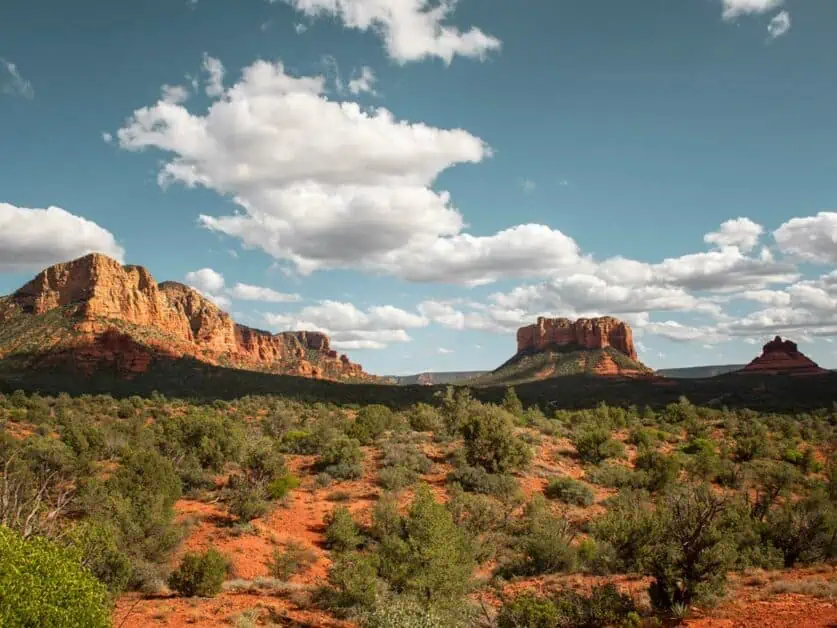
Learn About Native Culture
Many of the scenic sites in and around Sedona are rich in Native history. For example, the Birthing Cave, which you may hike to, is an incredibly sacred site and was used by pregnant women of the Sinagua tribe to give birth, which is now also recognized as an energy vortex (more on that above). Another example is the Palatki Heritage Site, detailed above, which was occupied by the same tribe then later, the Hopi people. It is possible to take tours of the cliff dwellings, and these allow you to learn about indigenous history in more detail. We would really recommend taking tours of some of the native sites in the area to learn more about these sacred areas and the rich history they hold.
Best Hikes Near Sedona, AZ
Use the map below to find the approximate starting locations for the hikes outlined. The numbers on this map correspond to the numbers below:
1. Birthing Cave Hike
Difficulty: With a steep ascent and light scramble at the Birthing Cave itself, this hike is classed as moderate
Distance: 3km/1.86miles
Elevation: 71m/233ft. ascent and descent
When to do it: Best to hike this trail between October and early June
The Birthing Cave hike is a real treat to get a sense of Sedona and can easily be completed in between one and two hours depending on your stops and speed. Whilst the hike in from the parking lot is relatively flat, the last section up to the Birthing Cave itself is very steep and slightly slippery with slick rock in places – so be sure to wear hiking shoes with a good grip and be sure footed.
Once you reach the cave, this is where the views really open out to show you the red rock that surrounds and frames you whilst you look at the mountains and mesa in front of you – it really is an incredible view and well worth the effort. There is very little shade on this trail, so be sure to bring plenty of water, sunscreen and a hat. This area, like many in Sedona are sacred Native Lands and are also sensitive sites – many including cryptobiotic crust, so you should always stick to trails and practice Leave No Trace principles.
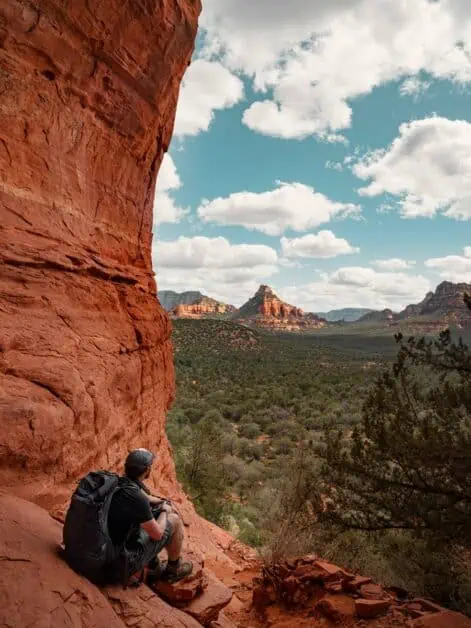
About our free downloadable trail maps: We use Outdooractive maps for all our hiking routes which gives you a live map that you can save offline for your hike. Cell service cannot be relied on around Sedona, so be sure to plan accordingly.
2. Sugar Loaf Loop
Difficulty: This hike is generally classed as easy to moderate
Distance: 3.2km/1.98miles
Elevation: 86m/282ft. ascent and descent
When to do it: You can hike this trail all year round
This is by far one of the best ‘bang for your buck’ trails in and around Sedona for the effort and time required for the views you get. Many people will hike the loop itself, but we’ve included the hike to the peak of Sugar Loaf as it’s well worth it for the extra views – particularly just before you make your way up the last hill section to the very top – you can see all the way out around the valley. You could easily complete this trail on an afternoon or first thing in the morning in an hour or so, depending on your speed and how much you want to stop. Be mindful that the parking lot is very small, and there is likely to be more space first thing or later in the day.
There is virtually no shade on this trail so be mindful of hiking in the hotter hours of the day, and make sure you bring water, a hat and sunscreen. If you wanted something with less elevation, you could miss out the summit entirely, and take the loop alone which has very little elevation gain.
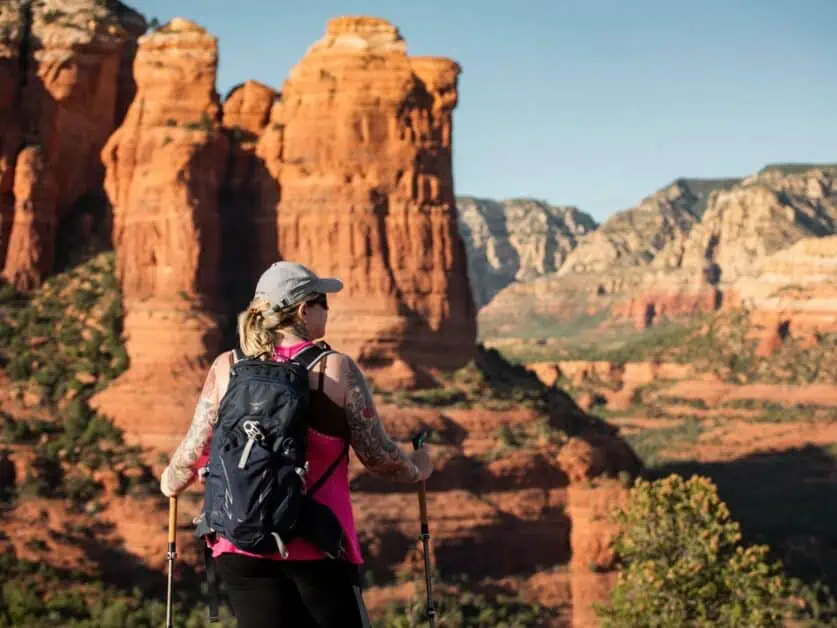
3. Courthouse Butte and Bell Rock Loop
Difficulty: This trail is classed as moderate
Distance: 6.1km/3.7 miles loop
Elevation: 117m/383ft. ascent and descent
When to do it: This trail can be hiked all year
Without a doubt, the Courthouse Butte and Bell Rock loop is one of the most iconic near Sedona. Some come for the views, others come for the vortex sites (you can read more about that above) but whatever you come for, this hike has stunning views of the quintessential Sedona landscape. It’s advisable to try and get to the parking lot first thing, or after lunch as it can get very busy. However, there is generally a good flow in and out of traffic so you shouldn’t be waiting too long for a space. Don’t let that fool you though, once you get out on this hike, you’ll likely see very few people, as this lot serves a number of activities.
You will need a Red Rock Pass, which you can buy a paper free version of at Recreation.gov. Alternatively, if you’re going to be visiting several places and National Parks in the area, it may make more sense for you to buy an American the Beautiful Pass which is accepted here too. You can purchase one online in advance here.
On the Courthouse Butte and Bell Rock hike, you will get to take in some stunning rock formations as you wind your way around the Courthouse Butte itself before approaching Bell Rock which you can take the short but steep climb up to have incredible views over the landscape. This hike really does give you some of the most stunning views around and is well worth the effort. As with all hikes in this area there is very little shade so water, sunscreen and a hat are a must.
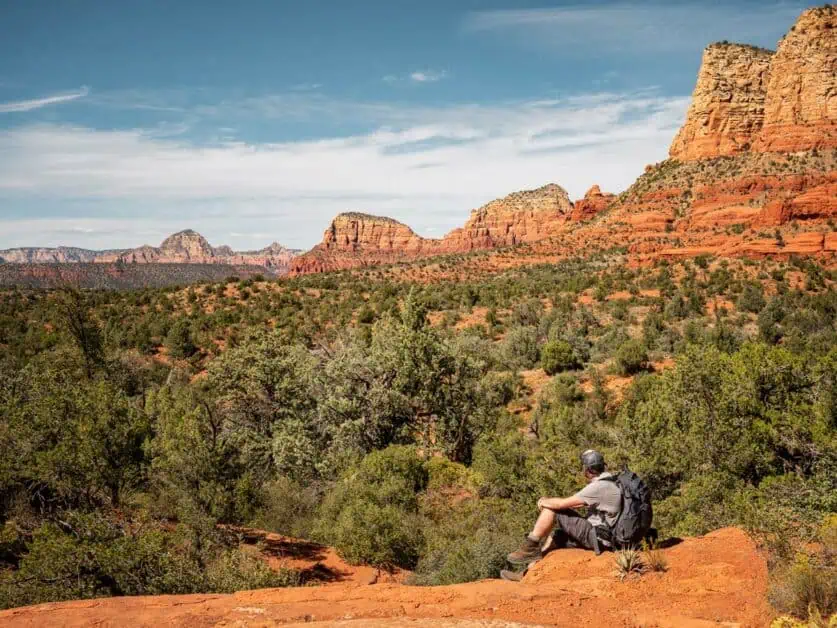
4. Crescent Moon Ranch at Red Rock Crossing Trail
Difficulty: This hike is classed as easy
Distance: 2.4km/1.49 miles
Elevation: 8m/26 ft. ascent
When to do it: You can hike this trail all year
Don’t let this short and sweet hike fool you – the views along the creek are wonderful and some of the most iconic views of Cathedral Rock can be seen reflected in the river pools along this trail. This trail is especially nice toward the end of the day, as the red rocks start to illuminate in the lowering sun (though be aware of bugs and bring spray). This is a great spot to go for a swim, and in fact the first pool you’ll come to from the parking lot is a very popular spot to enter the water, with some smaller pools found further along (depending on time of year and rainfall). You could easily make a few hours of it on this trail or take it steady and have a picnic.
You could also tack this onto the Cathedral Rock hike, for a different perspective of the trail. Whatever you do, you’ll want to bring your camera with you as the views are stunning! We’ve marked this trail to take you along to the end of the creek, but you can make this as short as you want, depending on what you’re looking for and the time you have available. A day use fee is payable upon entry (which can be paid with credit card), and this area is open at certain times. For more information on opening times and fees, visit the US Forest Service website.
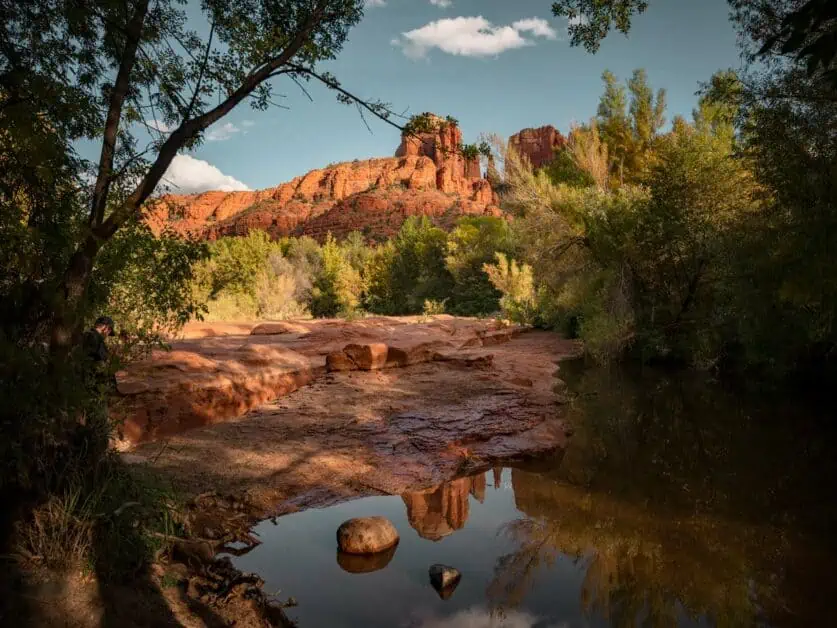
5. Cockscomb Trail
Difficulty: With significant distance and elevation, this trail is classed as moderate
Distance: 11.2km/6.95 miles
Elevation: 272m/892ft. ascent and descent
When to do it: You can hike this trail all year round
The Cockscomb Trail allows you to head up towards Doe Mountain for great views of the surrounding landscape and on a clear day, all the way down to Bell Rock. Be sure to head there early as this trail is popular, alternatively, later in the day. You’ll likely find the parking lot full by around 9:30am, even on a weekday. You can also take a detour to ‘Ground Control’ too if you want a slightly more challenging hike. You can also add an ascent up to Doe Mountain too, for even better views.
Whilst the hike is on the longer side, it is well graded and well-marked all the way through. This hike is very much a Sedona classic, but be sure to bring plenty of water, sunscreen, and a hat as there isn’t very much shade. It would also be easy to add-on Fay Canyon to this hike if you fancied extending it even further. Due to its approximation, you could also consider the Birthing Cave hike before or after this trail as well.
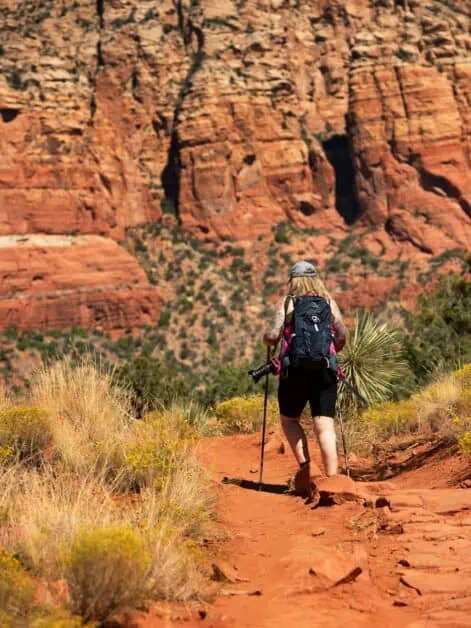
6. Little Horse Trail
Difficulty: This trail is classed as moderate
Distance: 6.5km/4miles
Elevation: 175m/574ft. ascent and descent
When to do it: It is possible to hike this trail all year round
Starting from quite close to the Bell Rock Trail outlined earlier, this trail couldn’t be more different and it’s a prime example of just how varied the rock sculptures and formations are in Sedona. Given that this area is popular with a small trailhead carpark, Sedona city offers a shuttle bus to the trailhead from a park and ride which you can find at 1294 SR 179. More information on that here. Be sure to check times on their site, but at present, it is free to travel and there is also no charge to park at the start location.
The view at Chicken Point is well worth the effort and you’ll likely find that this is a great alternative to Bell Rock and Cathedral Rock when they’re busy. The trail doesn’t require much technical hiking, so even though there is some ascent, may be suitable for hikers with slightly more limited mobility too. As with all Sedona hikes, bring sunscreen, a hat and water as there is very little shade on the trail.
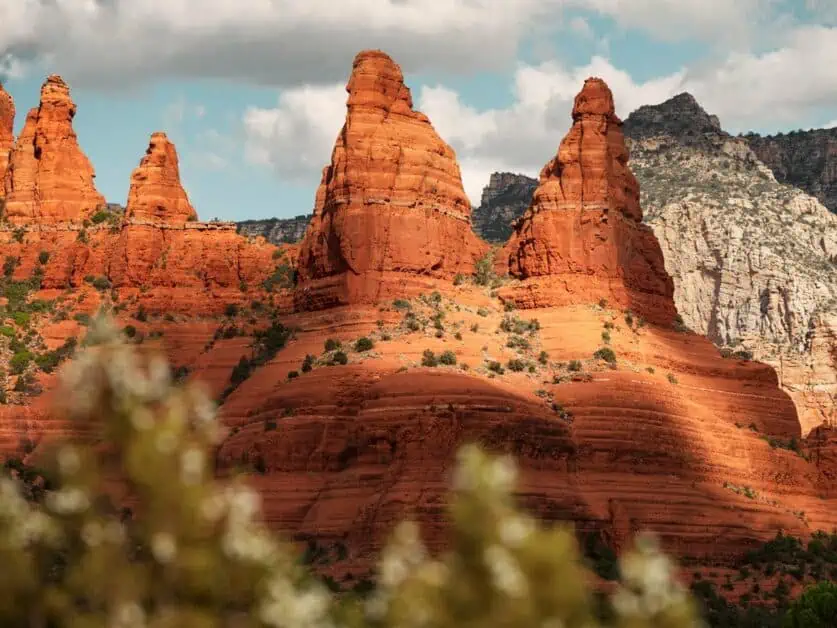
7. Herkenham Trail
Difficulty: This trail is classed as moderate
Distance: 4.7km/2.92miles
Elevation: 127m/416ft. ascent and descent
When to do it: This trail is suitable to hike all year round
This trail is that bit less well known so you’re likely to find it less busy – though there is only a very small parking lot. If you’re looking for a hiking trail in Sedona without so many crowds, then we’d really recommend you give this one a try. You get some absolutely incredible views out over the red rock spires and a seemingly endless panorama stretching off for miles. The trail is also great for mountain biking as there are some great downhill sections.
Keep in mind that you’ll hike downhill first, so your hike back is uphill, but if you’re up for it, you’ll enjoy this little hike with some challenging sections. Skywalker on your way back is really where the amazing views are!
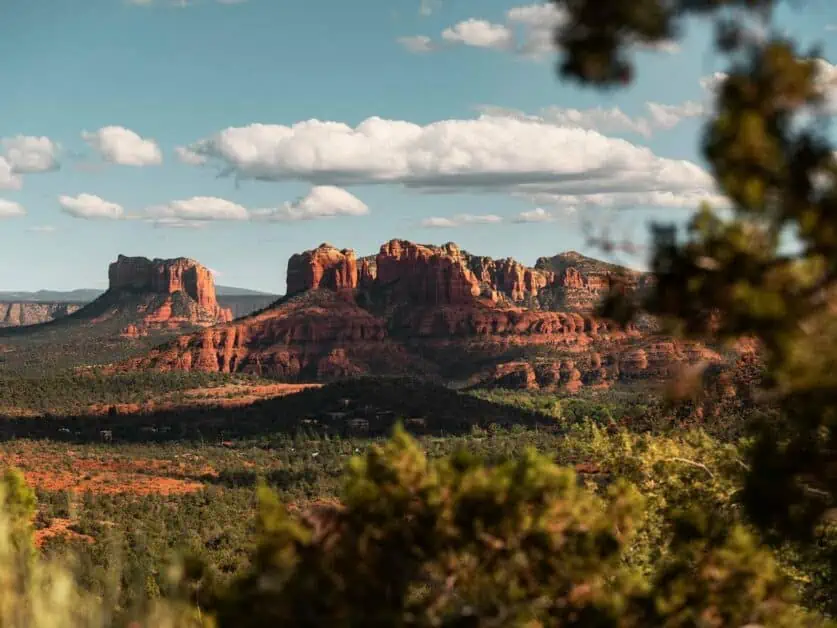
8. Cathedral Rock Hike
Difficulty: This hike is considered challenging
Distance: 2.8km/1.7miles
Elevation: 200m/656ft. ascent and descent
When to do it: This hike can be accessed all year
Cathedral Rock is possibly one of the most well-known, iconic hikes in Sedona. If you’re looking for a trail to yourself, this one might not be for you, however if you do decide to hike it, you won’t be disappointed. Cathedral Rock does need a little planning, especially if you’re visiting from Thursday to Sunday as there is no parking at the lot allowed during that time. You can alternatively use the free shuttle service from Sedona located at 1294 SR 179 – more information on the Sedona shuttle here (it’s also free to park at the start point). If you are visiting outside of those times, and you struggle to find parking, you can also start from both Baldwin and Templeton trails as alternatives.
Cathedral Rock is a challenging trail, there are sections of scrambling, and the rocks are well trafficked and slick, so proper footwear with a good tread is well advised. You may also want to consider limiting the items you bring with you or making sure everything is securely fastened in your backpack. Whilst you likely won’t have this trail to yourself, it is a fantastic hike that you’ll remember and is especially beautiful toward sunset. Bring plenty of sunscreen, a hat and water with you as there is no shade on this trail.
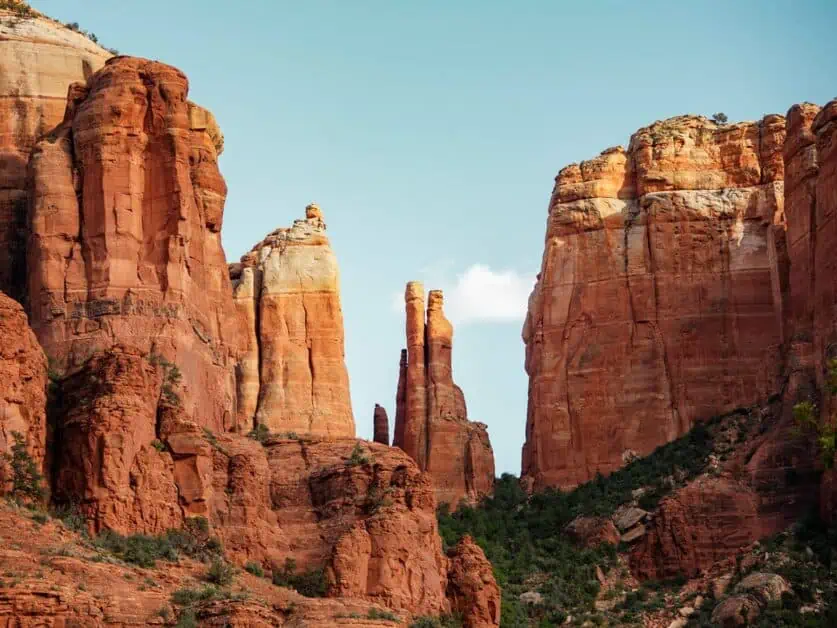
This is just a small selection of the hikes on offer – for more, check out our article on hikes in Sedona.
Places to Stay in Sedona, AZ
Sedona is a place that’s definitely geared towards tourism and, as such, there’s plenty places to stay in the town with options available to cater to all budgets and tastes. At one end of the scale, it’s possible to stay in fairly basic campgrounds whilst at the other, there are plenty of options for boutique and luxury hotels too. One thing to bear in mind is that Sedona does get very busy especially in the spring and autumn/fall peak seasons and this, in turn, can drive accommodation prices up. It’s possible that you simply might not be able to find anywhere to stay or anywhere to stay at a reasonably price. So booking places to stay well in advance is always recommended.
However, if this isn’t possible for whatever reason, and if you can’t find suitable or affordable accommodation in Sedona, Flagstaff offers a very valid alternative. This city is a very picturesque 45-minute drive (47.5km/29.5mi) from Sedona and offers a wealth of accommodation and food options.
Campgrounds & RVs
Camping is a very economical way to stay when exploring America and this is absolutely also the case in and around Sedona. The Forest Service operates a number of campsites in the Coconino National Forest that surrounds Sedona – most of these are to the north of Sedona in the spectacular Oak Creek Canyon. Oak Creek Canyon is wooded and the trees you’ll find around these sites provide welcome shade from the harsh desert sun. If you are travelling with a larger group, there’s also the Chavez Crossing Group Campsite which is walking distance from Sedona. Many of these sites are also suitable for mobile homes or RVs and these can be a great way to stay if your visit to Sedona is part of a wider road trip.
- Chavez Crossing Group Campground – This campsite is situated on the southern edge of Sedona and is just 4km/2.6mi from uptown – you could very feasibly walk in! As the name suggests, this campsite is geared towards larger groups and the assumption is that you will stay here as part of a group of at least ten people. Some of the pitches are suitable for larger RVs. The pitches vary in cost from between $95 and $235 and, whilst this might seem very expensive for a camp site, when you bear in mind that the pitches can accommodate anywhere between ten and 110 people, the costs actually represent amazing value. There is access to swimming spots on Oak Creek from the camp ground and on-site facilities include vault toilets and drinking water. This site can get busy, so advanced booking via recreation.gov is essential.
- Manzanita Campground – This camp site is situated 9.6km/6mi north from uptown Sedona on the 89a. It’s relatively close to Slide Rock State Park. This campground is in the spectacular Oak Creek Canyon and is surrounded by trees, offering welcome shade from the sun. Oak Creek flows right by the site and there are swimming and fishing spots right at the site. Pitches are $26 per night (if you wish to light a fire, you’ll need to buy firewood on site – you can’t bring your own to help prevent the spread of invasive species – and this costs $8 per bag). On-site facilities include vault toilets and drinking water. This camp site is only suitable for tents and smaller sleep-in vehicles. RVs and trailers are not allowed on this site. Advanced booking at recreation.gov is essential as this site can get busy.
- Cave Springs Campground – This large and popular campsite is 19km/11.7mi north of Sedona on the 89a. Situated on the floor of Oak Creek Canyon, this site is surrounded by trees and there are various hiking trails starting at the site. This site is suitable not just for camping in tents but also for RVs, trailers and motorhomes up to 11m/26ft in length. On-site facilities include vault toilets, drinking water, coin-operated showers and firewood and ice are also available to purchase (for $8 and $4 per bag respectively). A pitch costs $26 per night and advanced booking is essential.
- Pine Flat Campground – This campsite is north of Sedona in Oak Creek Canyon on the 89a. It is essentially next door to Cave Springs Campground (above) and is 20km/12.4mi from uptown Sedona. Facilities on site include drinking water, vault toilets and firewood and ice are also available at $8 and $4 per bag respectively. There are hiking trails and swimming spots in Oak Creek accessible right from the site and many of the pitches are directly on the river. Pitches cost $26 per night and advanced booking should be considered essential as this site can get very busy.
Hotels in Sedona, AZ
Sedona offer a wide range of different options in terms of hotels, B&Bs and vacation rentals. The town is a very popular destination, and accommodation can book-up quickly and be expensive. Whilst the cheapest accommodation options in Sedona may not be what many would consider truly budget-friendly, low-cost options are available. At the other end of the spectrum, the best luxury options are truly lavish and if you have the budget available, some of the nicest accommodation you could hope to find are available here:
- Adobe Grand Villas – Located in the quieter backstreets of West Sedona at 35 Hozoni Drive, AZ 86336, the Adobe Grand villas are a collection of self-contained vacation rentals that cater to the luxury end of the market. Each villa is individually styled and there is an on-site heated pool. The resort offers spa and private chef services. As you might expect, prices are premium.
- Briar Patch Inn – Located at 3190 N State Rte 89a, AZ 86336. Just north of Sedona, the Briar Patch inn offers a range of cabins in the woods of Oak Creek Canyon. Cabins of various sizes are available – many are suitable for families.
- Sugar Loaf Lodge – This family-run 70s style motel is located on highway 89a in West Sedona and within walking distance of uptown. This motel is a great option for budget-friendly accommodation right in the center of Sedona. The motel has a seasonal outdoor pool, year-round hot tub and barbeque and grill facilities outdoors.
- Alma De Sedona Inn – Located at 50 Hozoni Drive, AZ 86336 in Western Sedona, this hotel offers a range of relatively well-priced rooms all with private balconies or terraces offering exceptional views of the surrounding landscape.
- Ambiente Sedona – Located at 900 W State Rt. 89a, AZ 86336 in western Sedona, uptown Sedona is within walking distance. Accommodation is in self-contained luxury cabins and the resort also has a health spa and fine-dining restaurant on site. As you might expect, this is not a budget hotel, but for those who are seeking the last word in luxury, regardless of cost, the Ambiente ticks all the boxes.
Accommodation in Sedona can quickly book-up and consequently, it can also be expensive. The city of Flagstaff is a 45-minute drive (47.5km/29.5mi) north of Sedona and presents a great alternative for accommodation if you plan to visit the area. Flagstaff is a much larger city than Sedona and you’ll find many of the big chain hotels and motels present in Flagstaff alongside some more quirky and unique independently run accommodation:
- Motel Du Beau – This historic and independently-owned motel in the heart of Flagstaff has been lovingly renovated to provide visitors with an experience closer to a boutique hotel. The rooms are very reasonably priced, fitted out to a great standard and have their own character and the staff are super-friendly and helpful. There is also a kitchen you can use, as well as laundry facilities and a breakfast area. This is a fantastic place to stay, and we’d highly recommend!
- Hotel Monte Vista – You can’t get a more central location in Downton Flagstaff than this grand and historic hotel. Dating back to the 1920s, this has got to be one of the nicest buildings in the city. The hotel retains its period feel and has a rich, varied and sometimes sordid history. Whilst not necessarily the cheapest option, the rooms are budget-friendly, and the hotel also has a cocktail lounge, coffee bar, sushi restaurant and even a genuine speakeasy dating back to the prohibition era onsite.
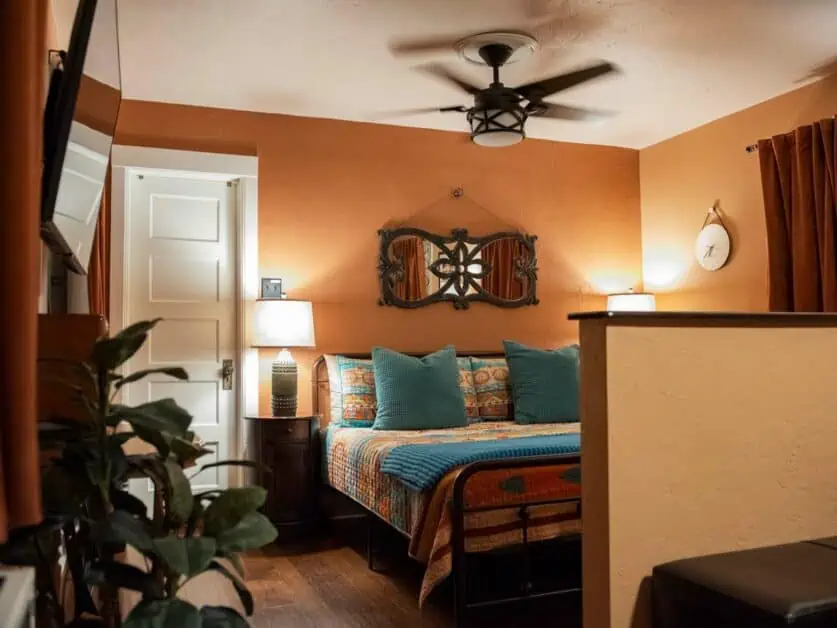
Where to Eat in Sedona, AZ
Sedona is not short on incredible places to eat that focus on fresh and beautiful produce, here are some of the best options:
- 89Agave Cantina – Located in uptown Sedona, 89Agave offers contemporary, authentic Mexican food in a sharp and modern dining room. They have a well-stocked bar with an extensive cocktail menu and are open from 7am to 10am for breakfast and then from 11am to 9pm seven days a week.
- ChocolaTree Organic Oasis – This place is truly special! Located in western Sedona, they offer delicious healthy food, smoothies, juices, coffees and home-made chocolates too. The food is 100% organic, and the entire menu is vegetarian with the majority being fully plant-based. They are open 10am to 4pm Sunday to Thursday and 10am to 8pm on Friday and Saturday.
- Wholefoods Market – The Sedona branch of Wholefoods is located at 1420 W State Rt. 89a, AZ 86336 in West Sedona. If you’re coming to Sedona to hike and want to pick up some food for the hike or just grab a quick bite or a coffee before you hit the trail, Wholefoods is a great option as they have an enormous fresh food area offering everything from pizza by the slice, freshly made sandwiches, burritos, sushi and a hot food and salad buffet.
If you choose to stay in Flagstaff instead of Sedona, there’s a wealth of food options available. You’ll find all the main chains you’d expect in an American city, but there’s also plenty of independently run options – the following just scratches the surface! The Red Curry Vegan Kitchen serves up delicious plant-based Thai food whilst Big Bowl Noodles – just across the street – offers customizable and very filling ramen. Late For the Train and Forêt both offer delicious barista coffee, cakes and breakfast. There’s also Fratelli’s Pizza, Dark Sky Brewing, The Toasted Owl and Plantasia, all of which have various dietary requirements met, such as vegetarian, vegan and gluten free.
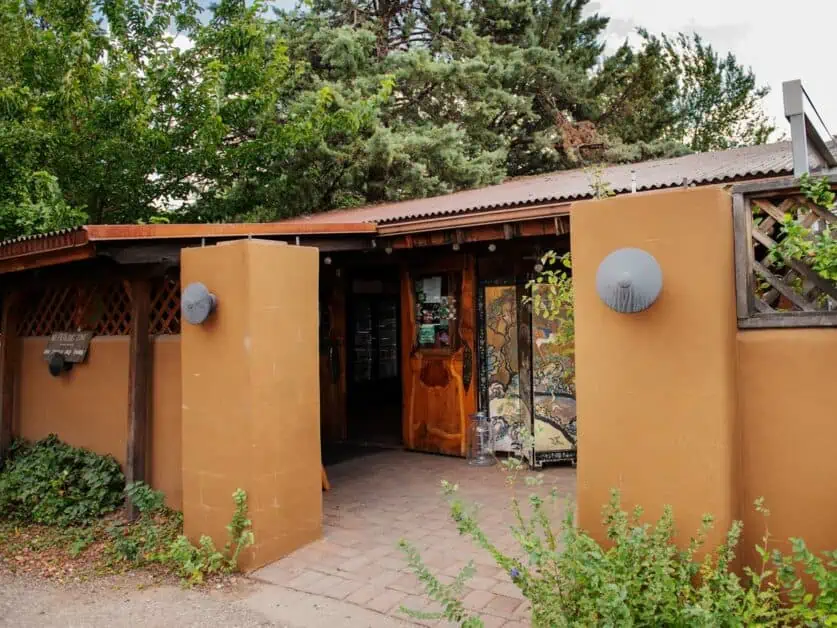
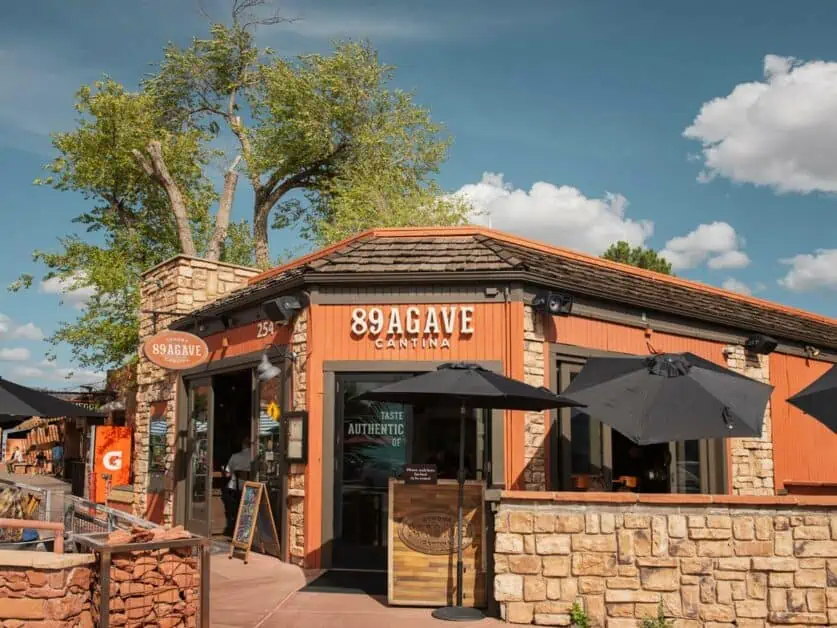
FAQs
What are some of the best things to do in Sedona without hiking?
There is plenty to do in Sedona without hiking, and above, we’ve outlined a number of things that will keep most interests busy. There is simply so much to do in Sedona, from 4×4 tours, to visiting vortex sites and swimming holes through to visiting the Palatki Heritage Site and taking a tour to learn about native heritage, shopping and more. There’s also a fantastic restaurant scene for foodies. You’ve also got horse riding and mountain biking a plenty (in fact, many of Sedona’s trails are suitable for downhill mountain biking, such as the Herkenham Trail, outlined above). Sedona shouldn’t just be seen as a place for hiking, and there is so much to do outside of this!
What are some free things to do in Sedona?
Provided you have a car, there are a variety of hikes you can do in Sedona that don’t involve paying for a Red Rock Pass or Interagency Pass such as the America the Beautiful Pass. They include the Birthing Cave hike and Sugar Loaf Loop to name a few. You can also drive the Red Rock Scenic Byway for free, and of course, visiting places like the Amitabha Stupa and Peace Park and the Tlaquepaque Arts & Craft Village are also free to enter.
What should I do with one day in Sedona?
If you’re really short on time in Sedona and only have a day to spend, we’d recommend a couple of shorter hikes, such as the Birthing Cave Hike and/or Sugar Loaf loop, which both give you fantastic red rock views in a short time. Eat lunch at ChocolaTree Organic to get refueled, then check out Tlaquepaque Arts & Crafts Village before heading to Crescent Moon Ranch where you can quickly walk down to the river/creek and take a swim in the swimming holes there or just take in the wonderful views that lead up to Cathedral Rock. Then, you can take a drive along the Red Rock Scenic Byway and stop off in some of the smaller spots to take photographs and really take in the views Sedona is famous for.
Where can I view red rock vistas in Sedona?
It’s easy to view plenty of beautiful red rock from anywhere in Sedona, as the area is completely surrounded! The view as you’re driving into Sedona from the Flagstaff area is particularly beautiful as you come into the valley in front of you. The Red Rock Scenic Byway is also a great way to take in some red rock. Visit Sedona also publish a guide to where you can see red rock in the area in a great fact sheet, which you can view here. One thing that’s for certain, you won’t be short on red rock in Sedona!
When is the best time to visit Sedona?
The most common times to visit Sedona are between March – May and from October – December. These will give some of the best temperatures for exploring where it’s not too hot and not too cold. That said, there is no specific best time to visit Sedona, and it has been described as having ‘perfect weather’. Just be mindful that it can become quite hot, and most hikes are very exposed, so be prepared.
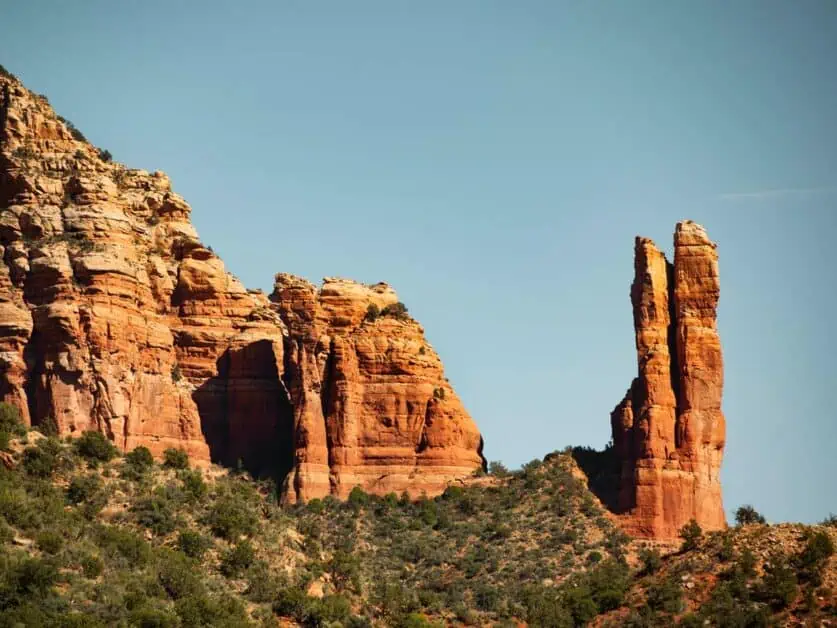
Conclusion
Sedona is an absolutely stunning location to visit and explore. It truly is a jewel, not just of Arizona, but also America. The landscape surrounding Sedona is truly spectacular and the hiking possibilities are all first rate. Many of the trails are easily accessible and deliver stunning views in short distances – making the area a great destination for less experienced hikers or those who want something a little more accessible. The real attraction of Sedona, though, is how this fantastic nature is combined with an amazing place to visit and stay.
The area itself is clearly very tourism-focused, but this is not a bad thing! The options in terms of places to stay, eat and just plain relax all add to the attraction and appeal of the area. Sedona also presents an unexpected face to the desert: the area is a lot greener than you might expect and Oak Creek – a companion that never seems to be too far away in the area – brings life to lush forests and orchards that seem at once out of place and welcome to see in the otherwise harsh desert. We’ll say it again: Sedona is stunning, and it is well worth taking the time to discover.
Disclaimer: This article contains Affiliate Links. You won’t pay any more for buying through these links, but we may receive a commission from any purchases made through them. As an Amazon Associate, I earn from qualifying purchases. If you choose to support us by buying through our links, we thank you as it helps us to continue providing the resources we do to help you enjoy the outdoors more!
